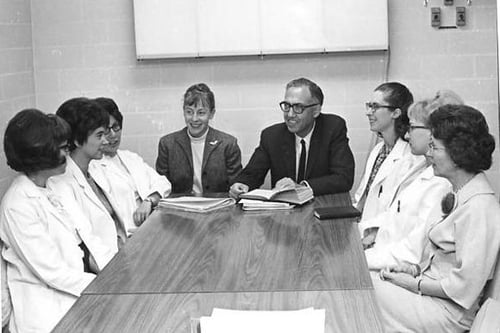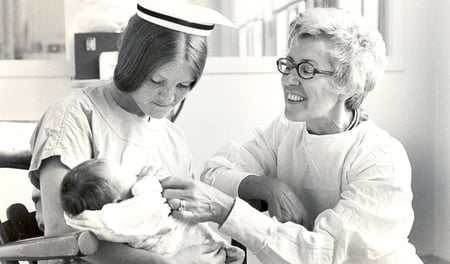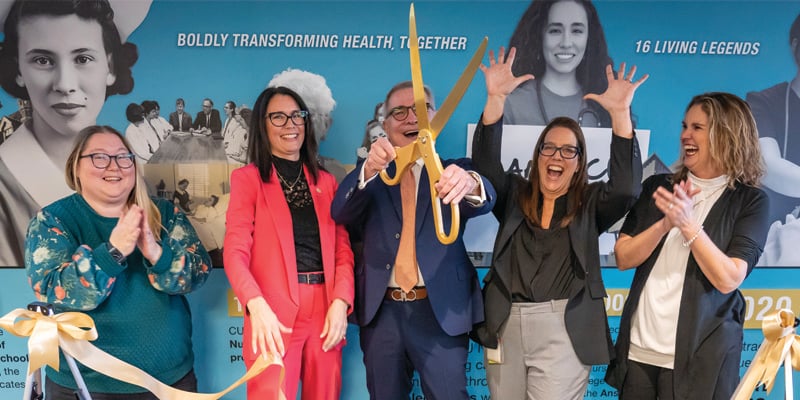America was rebuilding and growing after the end of World War II, and the University of Colorado School of Nursing was certainly no exception.
Enrollments doubled in large part due to the implementation of the GI Bill, designed to help veterans reintegrate into civilian life with low-cost mortgages, business loans and tuition assistance.
While many people of color were excluded from the benefits of the GI Bill, the legislation enabled beneficiaries to attend college, trade schools and other educational institutions at little or no cost – creating a more educated workforce, and ushering an era of economic prosperity for white Americans.
As construction began for dormitories and apartments for married students on the University of Colorado’s Boulder campus, university leadership successfully angled for research grants and specialty clinics focused on health concerns such as tuberculosis, epilepsy, and heart disease. The rich and powerful Bonfils family funded a cancer clinic which eventually evolved into an oncology division. Yet, despite this growth, the university was constrained by inadequate appropriations from the state.
Winds of change
With change in the air, Henrietta Adams Loughran, the dean of the CU School of Nursing from 1942 to 1965, envisioned a school that would effectively discard the old “apprenticeship” approach to nursing education in favor of a four-year academic program.
“We must not confuse nursing service with professional nursing care, for the terms are by no means synonyms,” Loughran asserted.
Ruth Colestock, an assistant dean who was instrumental in elevating the school to a university-level institution, envisioned a graduate program within the School of Nursing but knew that other schools in the Rocky Mountain region needed to create baccalaureate programs in order for the program to succeed. Fortunately, a substantial three-year ($58,180) grant from the W.K. Kellogg Foundation allowed the school to expand its curriculum and add faculty.
Collaborating with Colestock, Loughlin reorganized the school’s administration to emphasize advanced practice academic preparation at a master’s level rather than through certificates.
Where nurse practitioners were born
 Loretta Ford (far right) and Henry Silver (middle) 1966 |
One of CU Nursing’s most notable “bragging rights” is that it is the birthplace of the nurse practitioner. But by all historical accounts, pioneering the first nurse practitioner program was an uphill battle.
Founded by Loretta “Lee” Ford and Henry Silver in 1965, CU Nursing’s Nurse Practitioner Primary Care program was the first of its kind. Ford and Silver envisioned an expanded role for nurses and developed a curriculum focused on nursing care of the well child. The curriculum emphasized “values of accountability, holistic care, self-care, and clinical practice.”
Ford, who joined the US Army Air Force as a nurse in 1942 following her fiancée’s death in World War II, came to Denver and CU Nursing on the GI Bill. She earned a Bachelor of Science degree in nursing with a Public Health Nursing certificate in 1949 and a Master of Public Health Nursing Supervision in 1951.
After joining CU Nursing as an assistant professor, Ford was among the first wave of CU Nursing faculty to earn her Doctorate in Education in 1961. While training nurses in the field, Ford noticed disparities in healthcare, particularly in the rural and mountain areas of Colorado. Nurses were trying to fill the gaps of care.
“Henry Silver and Lee Ford were ostracized and mistreated. Henry once told me that at the time the hostility against him was so strong, he couldn’t walk down the halls of the CU School of Nursing.” – Former CU Nursing Dean Jean Watson, PhD ’73
Ford began developing more specialized curriculum, eventually teaming up with Silver to form the country’s first nurse practitioner program. While the concept would eventually change the course of healthcare forever, not everyone welcomed the idea with open arms at first.
“As I recall, our own internal faculty resisted the program because it had a medicalized component,” said former CU Nursing Dean Jean Watson, PhD ’73. “Henry Silver and Lee Ford were ostracized and mistreated. Henry once told me that the hostility against him was so strong, he couldn’t walk down the halls of the CU School of Nursing.”
 Loretta Ford and Student Nurse |
Upon being initially turned down by a state agency for a grant to develop a nurse practitioner program, the CU Medical School endowed Ford and Silver with $7,000 to initiate a demonstration project in the fall of 1965.
The program offered three to four months of didactic preparation and clinical practice. The major thrust of the program centered on the extended role of nurses within the community. Within two years, Ford and Silver had published encouraging results of a study in the American Journal of Nursing.
“The program itself seemed like an internship; it was purposefully hands-on,” said Maddie Nichols, PNP ‘67, part of the first cohort in the program, in a 2021 interview. “We had team meetings like grand rounds once a month on campus and Dr. Ford and Dr. Silver would lead the discussions.”
While the program was controversial among nurses at the time, it prepared a total of 64 nurse practitioners by 1972. By 1974, the American Nurses Association helped legitimize the role of NPs by establishing the Council of Primary Care Nurse Practitioners, which created an early description of an NP’s duties. To further standardize the designation, the ANA began offering NP certification exams in 1977.
Today, there are more than 355,000 nurse practitioners in the United States, though advanced-practice nursing is still in its infancy worldwide. Now 102 years old, Ford resides in Florida and is renowned for her sharp wit and intelligence.
Thriving in tumultuous times
The 60s and early 70s are generally regarded as a time of social and political upheaval, and progressive thinking. In 1971, CU Nursing faculty developed an “affirmative action” plan to increase the number of students, faculty, and staff of color. Faculty also established a SMILE committee to make the school a happier place.
As Americans were divided by the war in Vietnam, one CU Nursing graduate, Mary Dempsey, RN, MSN, volunteered for the US Army only two days after graduating and was shipped to Chu Lai, Vietnam during the bloodiest year of the war, 1967. A student of Lee Ford, Dempsey recounted her experience in a memoir, The Life and Times of Mary Katherine Dempsey-Noreika, written by Dempsey’s husband, John Noreika, Sr.
Amid the turmoil, CU Nursing continued to grow enrollment while amplifying its commitment to education, research, and service.
The next part of this series will explore transitions in nursing education from 1973 to 1998 – including CU Nursing’s influence in promoting the caring science movement.



